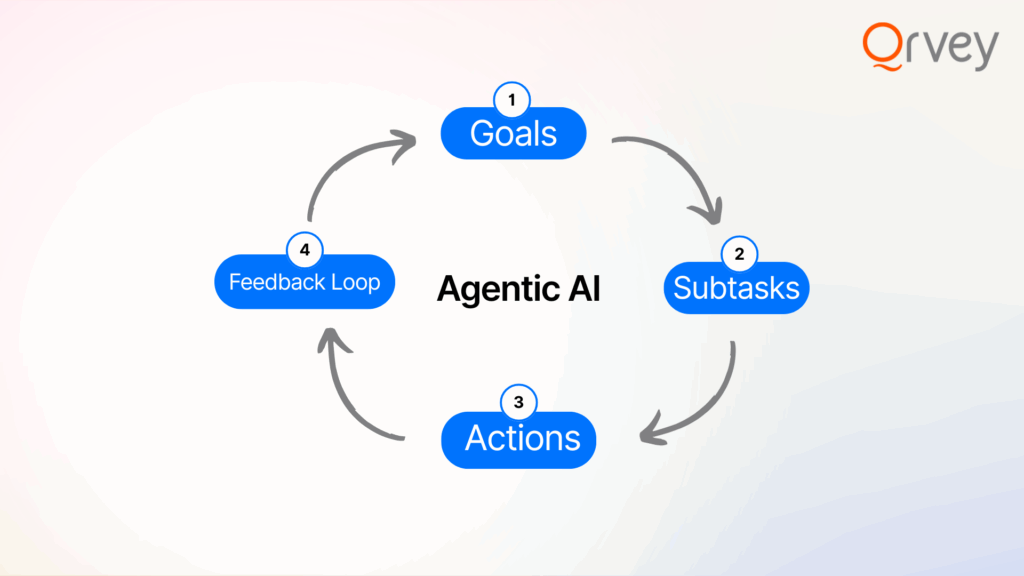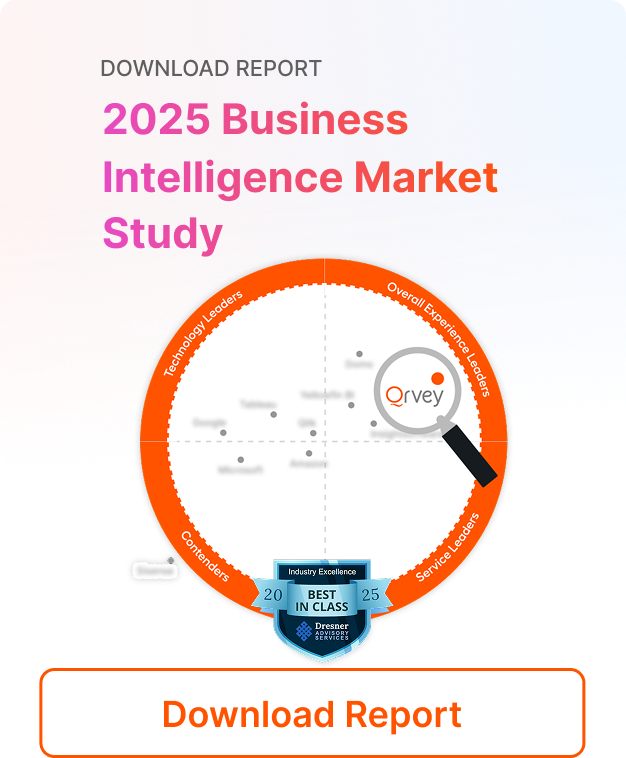
⚡Key Takeaways
- Agentic AI enables autonomous decision-making and action execution across workflows, reducing manual effort and accelerating outcomes.
- Use cases span industries including SaaS, healthcare, logistics, and business intelligence—solving gaps in speed, scale, and personalization.
- Qrvey leads in embedded analytics with agentic-ready workflows for multi-tenant SaaS platforms.
- Strategic benefits include faster resolution times, improved agility, and cost savings—while challenges like data governance and hallucination must be managed.
Manual workflows, siloed tools, and reactive decision-making are still common pain points across industries. Agentic AI offers a new paradigm—where intelligent agents not only analyze data, but act on it autonomously. And while every product owner is being pushed to develop an AI strategy, it isn’t always clear where AI will provide the biggest impact. If you’re searching for real-world agentic AI use cases, this article delivers 11 examples that solve business gaps in speed, scale, and efficiency.
We’ll explore how agentic AI works, where it’s already driving impact, and how platforms like Qrvey are enabling embedded analytics for SaaS companies with agentic capabilities.
What Is Agentic AI?
Agentic AI refers to autonomous systems that can break down goals into subtasks, make decisions, and execute actions—without human intervention. These agents orchestrate workflows, adapt to changing conditions, and learn from outcomes.

Agentic AI combines:
- Autonomy: Operates independently within defined boundaries.
- Orchestration: Coordinates across systems and APIs.
- Adaptability: Learns and adjusts based on feedback.
- Decision-making: Chooses optimal paths based on data.
11 Real-World Use Cases of Agentic AI
Use case #1 SaaS: Embedded Analytics from Qrvey
Qrvey’s platform enables agentic architecture in multi-tenant SaaS environments, where each tenant can receive personalized dashboards, alerts, and actions. For example, a product manager at a SaaS company can configure Qrvey to automatically detect usage anomalies, trigger CRM updates, and open support tickets—all without manual intervention. This insight-to-action loop empowers teams to respond faster to customer needs and optimize product performance in real time.
Use case #2 Healthcare: Patient Monitoring & Alerts
Agentic AI in healthcare leverages wearable devices and IoT sensors to monitor patient vitals continuously. When anomalies such as irregular heartbeats or oxygen drops are detected, agents autonomously alert care teams or initiate emergency protocols. For instance, a diabetic patient wearing a smart glucose monitor could receive insulin dosage recommendations or alerts sent directly to their physician, reducing hospital visits and improving chronic care management.
Use case #3 Logistics: Route Optimization & Dispatch
In logistics, agentic AI analyzes traffic patterns, weather conditions, and delivery constraints to reroute drivers dynamically. A delivery company might use agents to monitor real-time congestion and automatically assign alternate routes, notify customers of delays, and reallocate resources. This reduces fuel consumption, improves delivery accuracy, and enhances customer satisfaction—especially during peak seasons or adverse weather events.
Use case #4 Customer Support: Intelligent Ticket Routing
Agentic systems in customer support classify incoming tickets using NLP and sentiment analysis, then route them to the most appropriate agent or bot. For example, a billing-related query might be sent to a finance specialist, while a technical issue is escalated to engineering. These agents can also resolve common issues autonomously, such as password resets or subscription changes, freeing human agents to focus on complex cases.
Use case #5 Sales Enablement: Lead Scoring & Follow-Up
Sales teams benefit from agentic AI that scores leads based on behavioral signals—like email engagement, demo requests, or website visits. Agents can automatically assign high-scoring leads to sales reps, schedule follow-up calls, or send personalized emails. This ensures timely engagement and improves conversion rates. In B2B SaaS, for instance, agents might prioritize leads from companies showing high intent signals and route them to senior account executives.
Use case #6 Finance: Fraud Detection & Blocking
Agentic AI in finance monitors transactions in real time, identifying patterns that suggest fraud—such as duplicate charges, unusual geolocation activity, or rapid withdrawals. When flagged, agents can autonomously block transactions, notify users, and initiate investigations. This proactive approach minimizes financial loss and enhances trust. Banks and fintech platforms increasingly rely on agentic systems to stay ahead of evolving fraud tactics.
Use case #7 Retail: Inventory Replenishment
Retailers use agentic AI to track inventory levels across stores and warehouses. When stock falls below a threshold, agents automatically place orders with suppliers, factoring in delivery times, seasonal demand, and supplier reliability. For example, a fashion retailer might use agents to restock popular items before a promotional campaign, ensuring availability and maximizing revenue.
Use case #8 HR: Candidate Screening & Scheduling
In HR, agentic systems parse resumes, match qualifications to job descriptions, and shortlist candidates. They can also schedule interviews by syncing with calendars and sending automated reminders. This reduces time-to-hire and improves candidate experience. For high-volume roles, such as customer service or retail associates, agents can handle thousands of applications efficiently, ensuring top talent isn’t overlooked.
Use case #9 Marketing: Campaign Optimization
Agentic AI monitors campaign performance across channels—email, social media, search—and adjusts budgets, targeting, and creatives in real time. For instance, if a Facebook ad underperforms, the agent might reallocate budget to a higher-performing Google ad or tweak the messaging. This continuous optimization drives better ROI and allows marketers to respond instantly to audience behavior.
Use case #10 Manufacturing: Predictive Maintenance
Manufacturers deploy sensors and agentic AI to monitor equipment health. Agents detect signs of wear—like vibration anomalies or temperature spikes—and schedule maintenance before breakdowns occur. This reduces downtime, extends equipment life, and lowers repair costs. In automotive plants, for example, predictive maintenance agents help maintain production continuity and avoid costly delays.
Use case #11 Education: Personalized Learning Paths
Agentic AI in education adapts content delivery based on student performance, learning style, and engagement. If a student struggles with a concept, the agent might offer additional resources, quizzes, or switch to a different teaching method. Platforms like Coursera or Khan Academy use agentic systems to personalize learning at scale, improving outcomes and retention.
Five Strategic Benefits of Agentic AI
Agentic AI isn’t just about automation—it’s about transforming how businesses operate, scale, and serve customers. Below are key strategic advantages that agentic systems deliver across industries.
1. Efficiency & Speed
Agentic AI dramatically reduces the time it takes to complete complex workflows. By autonomously handling tasks like data analysis, decision-making, and execution, businesses can eliminate bottlenecks and manual handoffs.
For example, in customer support, agentic systems can triage tickets, assign them to the right team, and even resolve common issues without human intervention—freeing up agents for higher-value tasks.
2. Agility & Adaptability
Unlike traditional automation, agentic AI adapts in real time. It can respond to changing inputs, market conditions, or user behavior without needing reprogramming.
This agility is crucial in dynamic environments like logistics or finance, where conditions shift rapidly. Agentic systems can reroute deliveries, adjust pricing, or flag anomalies instantly—keeping operations resilient and responsive.
3. Personalization at Scale
Agentic AI enables hyper-personalized experiences without increasing operational complexity. Whether it’s tailoring marketing messages, learning paths, or product recommendations, agents can adapt content and actions to individual users.
AI In SaaS platforms, this means delivering unique dashboards, alerts, or workflows to each tenant—without manual configuration. Qrvey’s embedded analytics platform is a prime example, allowing agentic personalization across multi-tenant environments.
4. Cost Savings & Resource Optimization
By automating repetitive and decision-heavy tasks, agentic AI reduces labor costs and minimizes errors. It also optimizes resource allocation—ensuring that human talent is focused on strategic initiatives.
In manufacturing, for instance, predictive maintenance agents can prevent costly downtime. In HR, screening agents reduce time-to-hire and improve candidate quality.
5. Embedded Intelligence for SaaS
Agentic AI can be embedded directly into SaaS products, enabling smarter user experiences and operational workflows. Platforms like Qrvey offer native support for agentic orchestration—allowing SaaS teams to build intelligent features without reinventing the wheel.
This embedded intelligence empowers product teams to deliver value faster, differentiate their offerings, and scale innovation across customer segments.
Four Potential Challenges and Considerations
While agentic AI offers transformative benefits, it also introduces new risks and operational complexities. Below are key challenges businesses must address when adopting agentic systems.
1. Data Security & Governance
Agentic AI systems often require access to sensitive data across departments, platforms, and user profiles. Without robust governance, this can lead to data leakage, unauthorized access, or compliance violations.
Organizations must implement strict access controls, encryption protocols, and audit trails. Additionally, agentic systems should be designed to operate within clearly defined data boundaries—especially in regulated industries like healthcare or finance.
Tip: Use role-based access and anonymization techniques to limit exposure while maintaining functionality.
2. Hallucination & Accuracy
Like other AI models, agentic systems can hallucinate—generating incorrect or misleading outputs. When agents are empowered to take action autonomously, these errors can have real-world consequences, such as misrouted orders or false alerts.
To mitigate this, businesses should:
- Implement confidence thresholds before actions are executed.
- Use human-in-the-loop validation for critical decisions.
- Continuously retrain models with fresh, high-quality data.
Example: In customer support, an agentic bot might misclassify a billing issue as a technical one, leading to delays unless human oversight is built in.
3. Compliance & Regulatory Risks
Agentic AI must operate within the bounds of industry regulations—whether it’s GDPR, HIPAA, or financial reporting standards. Autonomous actions like data sharing or decision-making can inadvertently breach compliance if not properly constrained.
Organizations should:
- Conduct regular compliance audits.
- Use explainable AI frameworks to justify agent decisions.
- Ensure agents log all actions for traceability.
Pro Tip: Collaborate with legal and compliance teams during agent design and deployment.
4. Workforce Readiness & Change Management
Agentic AI changes how teams work. Employees may feel displaced or confused about their roles when agents begin automating tasks they previously owned.
Successful adoption requires:
- Clear communication about the role of AI agents.
- Training programs to upskill employees in AI collaboration.
- Change management strategies to foster trust and engagement.
Pro Tip: Keep Humans in the Loop
Even the most advanced agentic systems benefit from human oversight. Critical decisions, ethical considerations, and customer interactions should always include a human checkpoint.
Integrating Agentic AI Into Your Business
Adopting agentic AI is not just a technical upgrade—it’s a strategic shift. Successful integration requires thoughtful planning, cross-functional collaboration, and a clear understanding of where agentic systems can deliver the most impact.
Step 1: Identify High-Impact Use Cases
Start by mapping out workflows that are repetitive, data-driven, and decision-heavy. These are prime candidates for agentic automation. Examples include customer support triage, lead scoring, inventory management, and autonomous analytics.
Step 2: Choose Agentic-Ready Platforms
Not all AI platforms support agentic orchestration. Look for solutions that offer:
- API-first architecture
- Event-driven workflows
- Multi-tenant support
- Embedded analytics capabilities
Qrvey is a standout option for SaaS companies, offering agentic-ready infrastructure that integrates seamlessly into existing products.
Step 3: Design for Human-AI Collaboration
Agentic AI should enhance—not replace—human decision-making. Build workflows that allow agents to handle routine tasks while escalating complex or sensitive issues to humans.
Step 4: Pilot, Measure, and Iterate
Begin with a small-scale pilot focused on a single workflow. Define success metrics such as time saved, accuracy improved, or customer satisfaction uplifted. Use these insights to refine agent behavior and expand adoption.
Step 5: Ensure Cross-Functional Buy-In
Agentic AI touches multiple departments—IT, operations, compliance, and customer success. Engage stakeholders early to align goals, address concerns, and ensure smooth implementation.
Step 6: Train Teams and Build AI Literacy
Equip your workforce with the knowledge to collaborate effectively with agentic systems. Offer training on how agents work, what tasks they handle, and how to interpret their outputs.
Pro Tip: AI literacy is key to adoption. Teams that understand agentic workflows are more likely to trust and use them.
SaaS Leaders Trust Qrvey for Agentic AI Adoption with Embedded Analytics
Qrvey stands out as a leader in agentic AI for embedded analytics. Its platform enables SaaS companies to deliver intelligent, automated experiences to their customers—without building from scratch. With native tenant isolation, embedded authoring, and agentic-ready workflows, Qrvey helps teams move from insight to action in real time.
Ready to explore how Qrvey can power your agentic AI strategy? Visit Qrvey or read more about embedded analytics.

Arman Eshraghi is the CEO and founder of Qrvey, the leading embedded analytics solution for SaaS companies. With over 25 years of experience in data analytics and software development, Arman has a deep passion for empowering businesses to unlock the full potential of their data.
His extensive expertise in data architecture, machine learning, and cloud computing has been instrumental in shaping Qrvey’s innovative approach to embedded analytics. As the driving force behind Qrvey, Arman is committed to revolutionizing the way SaaS companies deliver data-driven experiences to their customers. With a keen understanding of the unique challenges faced by SaaS businesses, he has led the development of a platform that seamlessly integrates advanced analytics capabilities into software applications, enabling companies to provide valuable insights and drive growth.
Popular Posts
Why is Multi-Tenant Analytics So Hard?
BLOG
Creating performant, secure, and scalable multi-tenant analytics requires overcoming steep engineering challenges that stretch the limits of...
How We Define Embedded Analytics
BLOG
Embedded analytics comes in many forms, but at Qrvey we focus exclusively on embedded analytics for SaaS applications. Discover the differences here...
White Labeling Your Analytics for Success
BLOG
When using third party analytics software you want it to blend in seamlessly to your application. Learn more on how and why this is important for user experience.








